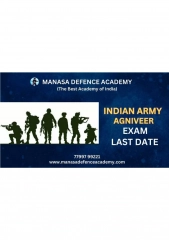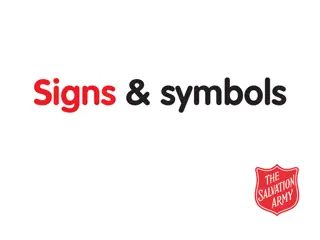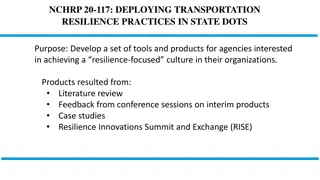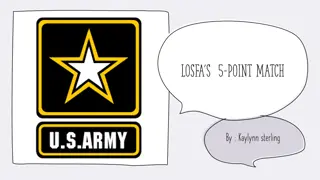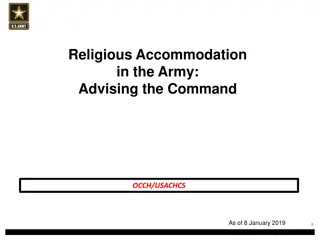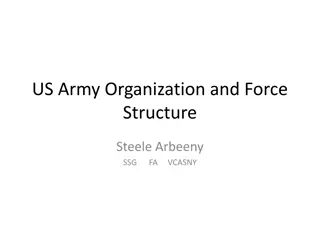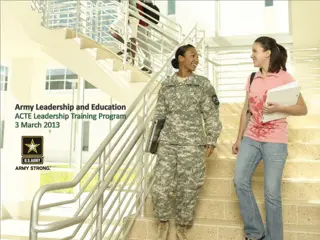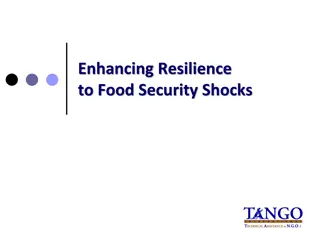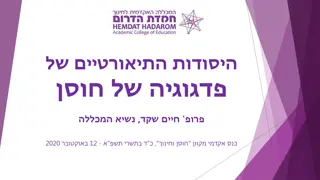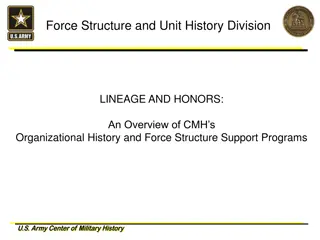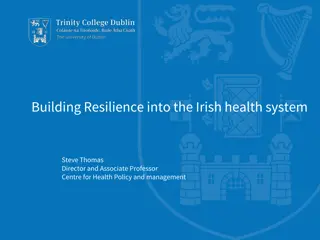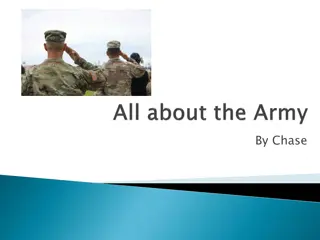Understanding Unit Resilience in the Army: Research Insights
Resilience at the unit level in the Army is essential for sustained performance and readiness. This research project, sponsored by the U.S. Army Research Institute, focuses on measuring and understanding team resilience components and their impact on overcoming stressors. The study aims to validate measures of core unit resilience through two studies conducted at Army installations and recruiting teams. Unit resilience, comprising cognitive, affective, and somatic aspects, is crucial for enhancing Army readiness and performance.
Uploaded on Sep 28, 2024 | 0 Views
Download Presentation

Please find below an Image/Link to download the presentation.
The content on the website is provided AS IS for your information and personal use only. It may not be sold, licensed, or shared on other websites without obtaining consent from the author. Download presentation by click this link. If you encounter any issues during the download, it is possible that the publisher has removed the file from their server.
E N D
Presentation Transcript
UNCLASSIFIED U.S. Army Research Institute for the Behavioral and Social Sciences (ARI) Soldiers, emergency responders and volunteers help set up the site for Freedom Walk, a 9/11 commemoration event at Fort Stewart, Ga. Click here for more details. This photo appeared on www.army.mil. Unit Resilience Measure Development and Validation Cassie Berry, Ph.D. Emerging Research Unit size1-army size1-army DoD HFE VTAG #74 November 2020 DISCLAIMER: The research described herein was sponsored by the U.S. Army Research Institute for the Behavioral and Social Sciences, Department of the Army. The views expressed in this presentation are those of the author and do not reflect the official policy or position of the Department of the Army, DOD, or the U.S. Government. Controlled by: ARI Unclassified Distribution Statement A POC: Cassie Berry, 703-545-2386 Cassie A. Berry1 (cassie.a.berry.civ@mail.mil), Colanda R. Cato1, Bridget E. Boyle1, Shala N. Blue1, Scott D. Tannenbaum2, John E. Mathieu2, and Jamie Levy2 1U.S. Army Research Institute for the Behavioral and Social Sciences, 2The Group for Organizational Effectiveness UNCLASSIFIED
UNCLASSIFIED The views expressed in this presentation are those of the authors and do not reflect the official policy or position of the Department of the Army, DoD, or the U.S. Government. UNCLASSIFIED Approved for public release. Distribution unlimited. The research described herein was sponsored by the U.S. Army Research Institute for the Behavioral and Social Sciences, Department of the Army (Contract No. W911NF-18-C-0024).
UNCLASSIFIED BLUF Team resilience = Team members collective confidence and capacity (cognitive, affective, somatic) to withstand and overcome stressors in a manner that enables sustained performance. Team resilience is not a simple aggregation of individual Soldiers resilience Ensuring units are highly resilient is critical to Army readiness Important to identify unit resilience components and understand the factors that can enable or diminish it Initial validation of Battery of measures Core unit resilience and other constructs (e.g. Stressors, Challenges) Technical Report and Administration Manual (under technical review) UNCLASSIFIED Approved for public release. Distribution unlimited. The research described herein was sponsored by the U.S. Army Research Institute for the Behavioral and Social Sciences, Department of the Army (Contract No. W911NF-18-C-0024).
UNCLASSIFIED Overview Purpose of measuring team resilience Two Studies Study 1 Army Installations Study 2 Army Recruiting Teams Summary Findings Applications Limitations Future research UNCLASSIFIED Approved for public release. Distribution unlimited. The research described herein was sponsored by the U.S. Army Research Institute for the Behavioral and Social Sciences, Department of the Army (Contract No. W911NF-18-C-0024).
UNCLASSIFIED Introduction Resilience at the unit level has been studied far less frequently than resilience at the individual level. Previously, no validated measure of unit resilience existed that is appropriate for research or practice in an Army context. Current project Items developed to measure three aspects of core unit resilience (Cognitive, Affective, Somatic) Measure validation in two studies Army Installations Army Recruiting Teams (online survey, at 3 time points) UNCLASSIFIED Approved for public release. Distribution unlimited. The research described herein was sponsored by the U.S. Army Research Institute for the Behavioral and Social Sciences, Department of the Army (Contract No. W911NF-18-C-0024).
UNCLASSIFIED Resilience Framework and Measures Stressors (15 items) Environmental Challenges (6 items) Core Unit Resilience (Current and Future, 12 items) 5-Item Short Form 2-Item Short Form Mending (10 items) Minimizing (6 items) Manifestations (11 items) UNCLASSIFIED Approved for public release. Distribution unlimited. The research described herein was sponsored by the U.S. Army Research Institute for the Behavioral and Social Sciences, Department of the Army (Contract No. W911NF-18-C-0024).
UNCLASSIFIED Sample Items Core Unit Resilience Low 10 10 --------------------- Medium ---------------------------- 20 30 40 50 20 30 40 50 High 100 100 Team Resources Rest Energy 60 60 70 70 80 80 90 90 Low 10 10 --------------------- Medium ---------------------------- 20 30 40 50 20 30 40 50 High 100 100 Team Resources Mutual trust Morale 60 60 70 70 80 80 90 90 Low 10 10 --------------------- Medium ---------------------------- 20 30 40 50 20 30 40 50 High 100 100 Team Resources Task- or mission-related knowledge Shared situational awareness 60 60 70 70 80 80 90 90 UNCLASSIFIED Approved for public release. Distribution unlimited. The research described herein was sponsored by the U.S. Army Research Institute for the Behavioral and Social Sciences, Department of the Army (Contract No. W911NF-18-C-0024).
UNCLASSIFIED Study 1 Army Installations Installation POCs at four locations identified squads 705 surveys collected, 679 usable surveys Represent 449 teams (factor structure and nomological net analyses) Multiple respondents for 129 teams (agreement indices and ICCs) Teams included a minimum of 2 members Focus is on team (we analyzed for both team and squad) UNCLASSIFIED Approved for public release. Distribution unlimited. The research described herein was sponsored by the U.S. Army Research Institute for the Behavioral and Social Sciences, Department of the Army (Contract No. W911NF-18-C-0024).
UNCLASSIFIED Results UNCLASSIFIED Approved for public release. Distribution unlimited. The research described herein was sponsored by the U.S. Army Research Institute for the Behavioral and Social Sciences, Department of the Army (Contract No. W911NF-18-C-0024).
UNCLASSIFIED Core Unit Resilience Both Studies Agreement justifies aggregation at team and squad level (i.e., rwgs >.70) Solid interrater agreement Significant ICCs of moderate levels (>.10, <.25) Except current physical fitness for Installations and future cognitions for Recruiting Teams Scales show high internal consistency throughout (i.e., Cronbach s s > .90). The Current and Future subscales and overall composites were highly and significantly correlated Either Current capacity or Future confidence sub-scale can be used as appropriate to fit situation interchangeable UNCLASSIFIED Approved for public release. Distribution unlimited. The research described herein was sponsored by the U.S. Army Research Institute for the Behavioral and Social Sciences, Department of the Army (Contract No. W911NF-18-C-0024).
UNCLASSIFIED Summary Findings Ample evidence for construct validity of both 12-item Core Unit Resilience scales Confirmatory factor analyses (CFAs) consistent across studies Can use three resilience factors or combine to one composite factor UNCLASSIFIED Approved for public release. Distribution unlimited. The research described herein was sponsored by the U.S. Army Research Institute for the Behavioral and Social Sciences, Department of the Army (Contract No. W911NF-18-C-0024).
UNCLASSIFIED Summary Findings Nomological network analyses encouraging No major modifications needed to the content of the measures Three versions of unit resilience 2-item; 5-item; Core Unit Resilience Measure (12 items) All three work similarly Brevity vs. Diagnosticity UNCLASSIFIED Approved for public release. Distribution unlimited. The research described herein was sponsored by the U.S. Army Research Institute for the Behavioral and Social Sciences, Department of the Army (Contract No. W911NF-18-C-0024).
UNCLASSIFIED Limitations Only two samples Will the findings generalize to other types of teams and settings? Somewhat smaller sample size with recruiting teams Same source data from Installation teams UNCLASSIFIED Approved for public release. Distribution unlimited. The research described herein was sponsored by the U.S. Army Research Institute for the Behavioral and Social Sciences, Department of the Army (Contract No. W911NF-18-C-0024).
UNCLASSIFIED Future Research and Example Applications Apply the measures in other settings, including deployed teams or training settings Sample teams resilience while under different forms and degrees of stressors Delve more deeply into team s responses and adaptations to stressors and how that may influence their subsequent resilience Consider other levels of aggregation beyond team and squad Test interventions designed to boost team resilience, perhaps using pre-post temporal designs Assess value and feasibility of adding unit resilience measure data to dashboards UNCLASSIFIED Approved for public release. Distribution unlimited. The research described herein was sponsored by the U.S. Army Research Institute for the Behavioral and Social Sciences, Department of the Army (Contract No. W911NF-18-C-0024).
UNCLASSIFIED Project Contact Information Dr. Cassie Berry Research Psychologist, Unit Resilience Emerging Research Unit, U.S. Army Research Institute for the Behavioral and Social Sciences (ARI) cassie.a.berry.civ@mail.mil Dr. Charles T. Keil Acting Chief Emerging Research Unit, U.S. Army Research Institute for the Behavioral and Social Sciences (ARI) charles.t.keil3.civ@mail.mil 703.851.7711 UNCLASSIFIED Approved for public release. Distribution unlimited. The research described herein was sponsored by the U.S. Army Research Institute for the Behavioral and Social Sciences, Department of the Army (Contract No. W911NF-18-C-0024).
UNCLASSIFIED Back-up Slides UNCLASSIFIED Approved for public release. Distribution unlimited. The research described herein was sponsored by the U.S. Army Research Institute for the Behavioral and Social Sciences, Department of the Army (Contract No. W911NF-18-C-0024).
UNCLASSIFIED Item Development Generated a pool of items based on the framework focusing on three hypothesized team resilience dimensions (Somatic, Affective, and Cognitive (SAC); Anderson & Gerbing,1991; Mathieu et al., 2019) 1) Affective includes team psychological states relating to feelings, attitudes, and emotion 2) Cognitive consists of team states that concern members thoughts or beliefs regarding a specific factor 3) Somatic states refer to members physical and mental conditions at any given time. UNCLASSIFIED Approved for public release. Distribution unlimited. The research described herein was sponsored by the U.S. Army Research Institute for the Behavioral and Social Sciences, Department of the Army (Contract No. W911NF-18-C-0024).
UNCLASSIFIED Content Validation Items piloted with Army SMEs (n = 9) for input/revisions Content validation with a second sample of SMEs (n = 36) were presented the 12 items in an online survey and mapped the items to the hypothesized dimensions Eleven of the 12 items were accurately categorized significantly more often than chance. Alertness was intended as an indicator of Cognitive (11%) but was actually classified more often as Somatic (23%). UNCLASSIFIED Approved for public release. Distribution unlimited. The research described herein was sponsored by the U.S. Army Research Institute for the Behavioral and Social Sciences, Department of the Army (Contract No. W911NF-18-C-0024).
UNCLASSIFIED Sample Items From 2-item Unit Resilience short form From Manifestations scale NO NEED to demonstrate this behavior During the last month, how often did your team exhibit this behavior when it was needed? Some of the Time Most of the Time Never or Rarely Every Time 1. Alerted one another to potential problems 1 2 3 4 5 2. Communicated about situational changes (for example: mission, resources) 1 2 3 4 5 3. Responded to challenges when they occurred 1 2 3 4 5 4. Sought assistance 1 2 3 4 5 5. Ensured all team members were comfortable speaking up 1 2 3 4 5 6. Offered backup or support when team members needed help (for example: overloaded, competing demands) 1 2 3 4 5 UNCLASSIFIED Approved for public release. Distribution unlimited. The research described herein was sponsored by the U.S. Army Research Institute for the Behavioral and Social Sciences, Department of the Army (Contract No. W911NF-18-C-0024).
UNCLASSIFIED Sample Items From Stressors scale During the last month how often did your team experience: Never Rarely Occasionally Frequently Constantly 1 2 3 4 5 1. information overload? 1 2 3 4 5 2. uncertainty or doubt? 1 2 3 4 5 3. lack of sleep? From Environmental Challenges scale UNCLASSIFIED Approved for public release. Distribution unlimited. The research described herein was sponsored by the U.S. Army Research Institute for the Behavioral and Social Sciences, Department of the Army (Contract No. W911NF-18-C-0024).
UNCLASSIFIED Study 2 Army Recruiting Teams Longitudinal, multi-source design Online survey; 275 recruiting stations; 49 companies; three time points (once a month for 3 months) Recruitersassessed their team s resilience Core Unit Resilience (Current and Future scales), 2-Item Unit Resilience Form (i.e., Overall Resilience) Station Commanders assessed all other factors Including Stressors, Environmental Challenges, Minimizing, Mending, Manifestations, Team Performance Team performance assembled from archival records (yields versus goals) 385 instances with team performance and recruiter survey data Of those, 210 also had station commander survey data UNCLASSIFIED Approved for public release. Distribution unlimited. The research described herein was sponsored by the U.S. Army Research Institute for the Behavioral and Social Sciences, Department of the Army (Contract No. W911NF-18-C-0024).
UNCLASSIFIED References Anderson, J. C., & Gerbing, D. W. (1991). Predicting the performance of measures in a confirmatory factor analysis with a pretest assessment of their substantive validities. Journal of Applied Psychology, 76, 732-740. https://doi.org/10.1037/0021- 9010.76.5.732 Mathieu, J. E., Luciano, M. M., D Innocenzo, L. D., Klock, E. A., & LePine, J. A. (2019). The development and construct validity of a team processes survey measure. Organizational Research Methods. https://doi.org/10.1177/1094428119840801 UNCLASSIFIED Approved for public release. Distribution unlimited. The research described herein was sponsored by the U.S. Army Research Institute for the Behavioral and Social Sciences, Department of the Army (Contract No. W911NF-18-C-0024).




